Fig. 3.1
Jejunocolic bypass
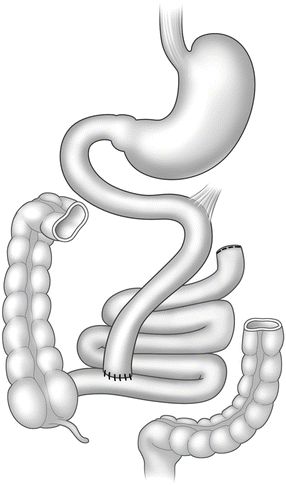
Fig. 3.2
End-to-side jejunoileal bypass
By the late 1960s and early 1970s, there were a number of reports of successful weight loss being produced by jejunoileal or jejunocolic shunts. Each of these studies identified complications that were directly associated with the intestinal bypass procedure. As these reports became more numerous, it produced an extremely fertile field for a number of researchers to investigate the various mechanisms of action that produced the metabolic aberration. Perhaps, the most interesting and best studied side effect of intestinal shunting was the development of liver failure in certain patients. In Payne’s original report, all of the patients had liver biopsies and the vast majority demonstrated steatosis of the liver. Many surgeons paid little heed to this observation. After all, the patient was fat and had fat everywhere else, why not in the liver. If the excluded limb of intestine was resected, liver failure did not occur, although these patients did experience malabsorption and weight loss. When liver failure occurred, biopsies of the liver looked identical to alcohol-induced cirrhosis, even to the point of including Mallory’s bodies. Many curmudgeons opined that these patients must be closet alcoholics. That was clearly not the case. Certain investigators demonstrated bacterial overgrowth of gram-negatives and anaerobic bacteria in the excluded limb of intestine along with morphological changes in the intestinal wall (separation of tight junctions between enterocytes) and felt that this played a role [4]. These investigators coined the term “enterohepatic syndrome.” Other complications of intestinal shunting procedures included malnutrition, vitamin deficiencies (especially of fat-soluble vitamins), electrolyte abnormalities (especially of divalent cations), ketosis, iron malabsorption, hyperoxaluria, nephrolithiasis, migratory arthralgia, profound inflammation of synovial lined spaces, and in some individuals weight regain. Although the benefits were profound, so were the complications. The second-ever National Institutes of Health (NIH) Consensus Development Conference was held in 1978 [5]. The focus was the treatment of morbid obesity, including surgical intervention. Although the recommendations were favorable for certain operative procedures in the treatment algorithm, it was felt that the risk-benefit ratio for intestinal shunting procedures was too high to recommend routine use.
Up to this time, the academic surgical community had shown little interest in the development of bariatric surgery. The individuals doing bariatric surgery were felt to be somewhat of a renegade group of surgeons who were involved in the treatment of a “condition” that was simply the end result of gluttony and sloth. This prejudiced view augmented the discrimination against the patients, their disease, and the surgeons and staff who treated them. It was a commonly held belief that seriously obese individuals simply lacked willpower. Surgeons who lowered themselves to treat individuals that were affected by obesity, which was not a serious disease (like cancer), deserved the headaches inherent in the care of such patients. It was a waste of resources that could have been used in the treatment of “real” surgical problems such as duodenal ulcer disease.
There was little or no appreciation that obesity was a disease and intimately associated with other diseases such as type II diabetes, hypertension, cardiovascular disease, and an increased incident of certain malignancies. There was a failure to understand that the underlying inflammatory process associated with severe obesity affected every system in the body to a greater or lesser degree. It was not realized that control of the obesity would be associated with increased longevity and general health.
There was a real schism between believers that obesity was a disease state and those that did not adhere to this premise. Department chairs grudgingly allowed young surgical faculty to do bariatric surgery as it produced volume in the operating room and technical experience for residents. Bariatric surgery was often looked upon as a nuisance that had a tendency to congest intensive care units with long-term stay patients. Academic advancement for young surgeons occurred in spite of their involvement in bariatric surgery not because of their achievements in this area. National meetings rarely accepted papers about bariatric surgery, and when papers were accepted they almost always dealt with the management of complications that might be pertinent to similar complications that occurred in normal weight individuals. The papers were always positioned at the worst spot on the program.
By the early 1970s, certain surgeons became sensitized to the complications associated with malabsorptive procedures and looked for alternatives. From a simplistic standpoint, if allowing patients to eat large volumes of food and then interrupting absorption by short-circuiting the intestine did not work, perhaps limiting intake would.
At the University of Iowa, there were strong connections to the University of Minnesota. Not only were they in relative proximity, but many of the faculty at Iowa had been educated in part at the University of Minnesota. Edward E. Mason was interested in the gastrointestinal tract and specifically in peptic ulcer disease. Working with Chikashi “Chick” Ito, Mason performed a side-to-side anastomosis between the very upper third of the divided stomach and a loop of jejunum to treat duodenal ulcers disease (Fig. 3.3). A number of the patients were obese and Mason observed that although the procedure did not control the ulcers, it was associated with weight loss. He reported this in a 1967 publication during the peak of popularity for the jejunoileal bypass [6]. The paper was somewhat confusing to the surgical community as it reported results for patients with two different diseases. As these patients were followed longer term, weight regain was observed. Over the subsequent 8 years, Mason published three more papers modifying the procedure by first making the anastomosis between the stomach and jejunum smaller and then substantially decreasing the gastric pouch size. The problems were multiple. The procedure was performed high in the abdomen and therefore was technically demanding and the enlarged left lobe of the liver was often problematic. Staplers were not available in the early years. Although early weight loss was obtained, weight regain occurred in many patients by 6 months. Because the procedure involved a loop of jejunum, regurgitation of small bowel content into the gastric pouch frequently occurred. Alden solved some of the problems by doing away with the loop and creating in Roux-en-Y limb for the gastrojejunostomy [7] (Fig. 3.4).
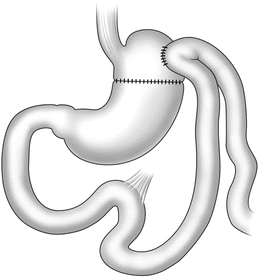
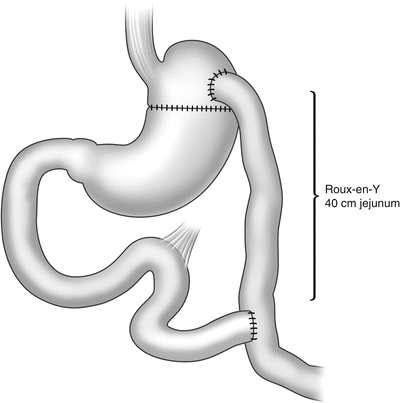

Fig. 3.3
Side-to-side anastomosis

Fig. 3.4
Roux-en-Y limb for gastrojejunostomy
Mason continued to modify his procedure and by the mid-1970s had first performed a gastric partition with the opening on the greater curvature of the stomach. This was done only in a small number of patients and did not seem to produce long-term weight loss (Fig. 3.5). By 1975, Tretbar, Echout, Fabito, Laws, O’Leary, and others had performed a vertical gastric partition along the lesser curvature of the stomach and controlled the outlet using a variety of devices from chromic suture to a silicone ring [8] (Fig. 3.6). Staplers were critical in the development of such a partition. Mason modified his approach by placing an end-to-end anastomosis (EEA) stapler through the stomach at the distal end of the lesser curvature cylindrical gastric tube and placing a piece of Marlex® mesh through the hole and back up through an aperture at the lesser curvature of the stomach sparing the nerve of Laterjet [9] (Fig. 3.7). This vertical banded gastroplasty gained considerable popularity and for a period of time in the early 1980s was probably the most commonly performed bariatric operation in the United States of America.
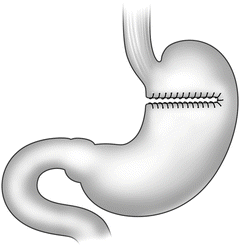
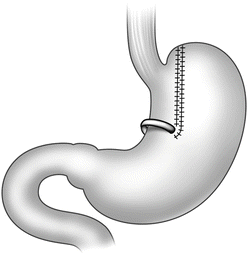
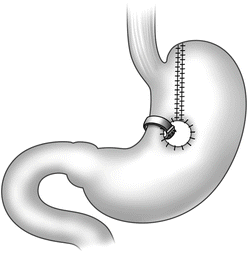

Fig. 3.5
Gastric partition with the opening on the greater curvature of the stomach

Fig. 3.6
Vertical gastric partition along the lesser curvature of the stomach with the outlet controlled with a silicone ring

Fig. 3.7
End-to-end anastomosis through the stomach at the distal end of the lesser curvature cylindrical gastric tube with a piece of Marlex mesh through the hole and back up through an aperture at the lesser curvature of the stomach
The same NIH Consensus conference that spelled the demise of the jejunoileal bypass surgery opened an alternate avenue for gastric restrictive procedures. A variety of different mechanisms had been explored to partition the stomach. Various surgeon pioneers began to perfect the operative techniques surrounding gastric bypass procedures. Investigators from the University of Kentucky and the University of North Carolina published comparison studies between the intestinal bypass procedure and gastric bypass [10, 11]. Complications were clearly less in the gastric procedures and weight loss was equivalent. During the 1980s, Mason continued to champion gastric restriction using the banded gastroplasty. Various modifications of these procedures were proposed.
In an ingenious modification of the silastic ring championed by Laws, L. Kuzmak invented a silastic ring with a small balloon embedded on the inner aspect of the ring that could be accessed from a subcutaneously placed reservoir [12]. This allowed calibration of the outflow lumen (Fig. 3.8). With this innovation, adjustable gastric banding was born.
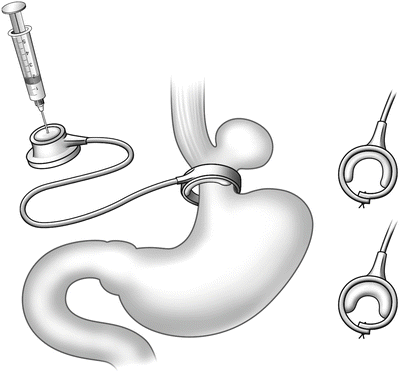

Fig. 3.8
Adjustable gastric banding. A silastic ring with a small balloon embedded on the inner aspect of the ring that could be accessed from a subcutaneously placed reservoir
At this phase in the development of bariatric surgery, which occurred in the 1980s, a number of individuals adopted the philosophy that gastric restrictive procedures—including gastric bypass, which was thought at that time to be primarily a restrictive procedure—were associated with less in the way of postoperative complications, produced satisfactory weight loss, were associated with amelioration of the complications of obesity, and were technically reasonable to perform. Gastric restrictive procedures benefited enormously from advances in technology, especially in the area of stapling devices. Surgeons also learned many invaluable lessons as to the management of obese individuals after other intra-abdominal procedures. These lessons were accepted by the general surgeons, who were not necessarily doing bariatric surgery, but operating on seriously obese people for other causes.
Not all of the advances in bariatric surgery were confined to the North American continent. Bariatric surgery was beginning to become recognized in Europe, South and Central America, and to a lesser degree in Asia. One of the most prolific writers from the European continent was Nicola Scopinaro, who in 1979 had devised an operation he termed the biliopancreatic diversion (BPD) [13]. Scopinaro performed a generous gastrectomy, usually leaving a gastric remnant about one-third the size of the original stomach. He then divided the small intestine at about its midpoint and brought the ileal end up to be anastomosed to the stomach remnant. The other end of the intestine that carried the biliary and pancreatic excretions was anastomosed to the side of the ileum, approximately 120 cm from the ileocecal valve (Fig. 3.9). This produced an abbreviated channel where the digestive juices mixed with ingested food. Scopinaro reported excellent weight loss results. His patients underwent a large number of metabolic studies that demonstrated amelioration of many of the comorbidities associated with morbid obesity. He did acknowledge many of the side effects seen in the previously discussed malabsorptive procedures, especially those having to do with iron and divalent cation absorption as well as absorption of fat-soluble vitamins. From the literature, it would appear that his patients required diligent and prolonged follow-up, but with this type of management, Scopinaro reported excellent long-term results [14].
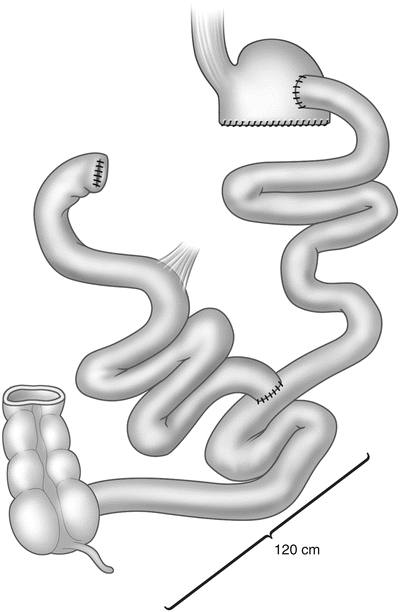

Fig. 3.9
A generous gastrectomy leaving a gastric remnant about one-third the size of the original stomach. The small intestine is divided at about its midpoint and the ileal end is brought up to be anastomosed to the stomach remnant. The other end of the intestine that carried the biliary and pancreatic excretions is anastomosed to the side of the ileum, approximately 120 cm from the ileocecal valve
Metabolic
As the decade of the 1980s drew to a close, the field of bariatric surgery had stabilized. Much had been learned and applied over the preceding 25 years. The surgeon’s knowledge about the disease had improved substantially. The understanding of complex hormonal mechanisms and detailed physiology was at a much higher level than ever before, although still quite incomplete. The vast majority of procedures were gastric restrictive procedures, with the most common operation performed being the gastric bypass. The bariatric surgical community could now perform this type of surgical intervention with an operative mortality of less than 1 % and morbid complications occurring in less than 6 % of patients. The beneficial effects had now been clearly documented in certain areas. Although insurance coverage was not widely available, certain payers were beginning to cover the procedures. The field of surgery for morbid obesity was poised at the precipice, awaiting the next great breakthrough. These change agents came in two forms.
The first was a report by MacDonald and Pories published in 1995 detailing the beneficial effect seen in obese individuals with adult-onset (type II) diabetes who had undergone a Roux-en-Y gastric bypass [15




Stay updated, free articles. Join our Telegram channel

Full access? Get Clinical Tree






